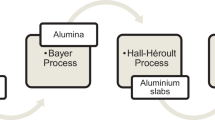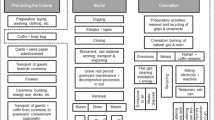Abstract
Purpose
For countries like Singapore that is highly dependent on imported goods, it is essential to consider the consequences of consumption of imported cement and other concrete constituents for a fair carbon trading at global and regional levels. Recently, as a result of reduction in trade barriers and costs of materials and fuels, Singapore does not have much incentive in reducing environmental impacts of these imported goods. However, Singapore has set high environmental targets nationally to reduce impacts from building and construction. In addition to its national efforts, Singapore also needs to take action in trade-related consequences of importing energy-intensive products like cement and aggregates to Singapore. The purpose of this study is to quantify and suggest alternatives for reducing the embodied energy and life-cycle impacts of concrete consumption in Singapore on the basis of current trading volumes of these materials from Singapore’s importers.
Methods
A detailed life-cycle assessment of concrete manufacturing in Singapore is performed to suggest possible ways to reduce the environmental impacts from importing cement and aggregates from Singapore’s trade partners based on an earlier life-cycle inventory developed for Singapore and its neighboring countries. Life-cycle impact assessment (LCIA) impact characterization factors are based on a midpoint-oriented and hierarchist approach as defined by ReCiPe method. Following the LCIA, a scenario analysis is conducted to select the best combination of cement and aggregate importers of Singapore based on their environmental performance.
Results and discussion
Results from the scenario analysis show that overall impacts can be reduced by importing the materials from a nearer source with efficient production technologies and greener fuel mixes. About 10–34 % reduction is estimated in embodied energy, acidification, eutrophication, global warming potential, smog, and health impacts by importing from a closer and technologically greener source.
Conclusions
Despite the limitations due to data and modeling uncertainties, this study constitutes a baseline/benchmark for addressing the current cement and aggregate markets and associated environmental impacts of concrete consumption in Singapore based on historical import quantities of cement and aggregates from neighboring countries of Singapore. In the near future, policy-related action would be influential in achieving Singapore’s national and global environmental targets in buildings and construction sector. Incorporation of an LCA approach into Green Mark Scheme (GMS) by the Building and Construction Authority (BCA) is recommended for Singapore to comply both with its national goals and with its new climate action plan to the UN Framework Convention on Climate Change.














Similar content being viewed by others
References
Al-Jabri KS, Hisada M, Al-Oraimi SK, Al-Saidy AH (2009) Copper slag as sand replacement for high performance concrete. Cement Concrete Comp 31:483–488
Alsop PA, Chen H, Tseng H (2007) The Cement Plant Operations Handbook, 5th edn. Tradeship Publications, Surrey, UK
Asif M, Muneer T, Kelley R (2007) Life cycle assessment: a case study of a dwelling home in Scotland. Build Environ 42:1391–1394
Athena (2015) Athena Institute Website. ATHENA®—Athena Sustainable Materials Institute., http://www.athenasmi.org/. Accessed 24 Aug 2015
BCA (2015a) Annual construction material demand—construction industry reports. Building and Construction Authority of Singapore., http://www.panunited.com.sg/construction-report. Accessed 26 Jul 2015
BCA (2015b) BCA Green Mark Assessment Criteria. Building and Construction Authority., http://www.bca.gov.sg/greenmark/green_mark_criteria.html. Accessed 25 May 2015
Benetto E, Rousseaux P, Blondin J (2004) Life cycle assessment of coal by-products based electric power production scenarios. Fuel 83:957–970
Bhatty JI, Miller FM, Kosmatka SH (2004) Innovations in Portland cement manufacturing. vol SP400. Portland Cement Association [PCA]
Boesch ME, Hellweg S (2010) Identifying improvement potentials in cement production with life cycle assessment. Environ Sci Technol 44:9143–9149
Boesch ME, Koehler A, Hellweg S (2009) Model for cradle-to-gate life cycle assessment of clinker production. Environ Sci Technol 43:7578–7583
Department of Statistics, Singapore (2015) Table Builder for Building, Real Estate, Construction and Housing - Contracts Awarded And Progress Payments Certified By Sector And Development Type, Annual. Government of Singapore. http://www.tablebuilder.singstat.gov.sg/publicfacing/createDataTable.action?refId=8374. Accessed 27 Jul 2015
Deru M, Torcellini P (2007) Source energy and emission factors for energy use in buildings. National Renewable Energy Laboratory, Golden, Colorado
Dimoudi A, Tompa C (2008) Energy and environmental indicators related to construction of office buildings. Resour Conserv Rec 53:86–95
EIA (2010) Annual Coal Report 2010. U.S. Energy Information Administration—Office of Oil, Gas, and Coal Supply Statistics. U.S. Department of Energy, Washington, DC
EIA (2011a) Annual Energy Outlook 2011 with projections to 2035. U.S. Energy Information Administration, Washington, DC
EIA (2011b) Coal production and number of mines by state and coal rank, 2010. U.S. Energy Information Administration - Assistant Administrator for Energy Statistics Office of Electricity, Renewables, and Uranium Statistics, Washington, DC
EMEP/CORINAIR (2006) EMEP/CORINAIR Emission Inventory Guidebook. European Environment Agency—Co-operative Programme for Monitoring and Evaluation of the Long Range Transmission of Air Pollutants in Europe (EMEP) and The Core Inventory of Air Emissions in Europe (CORINAIR)
EPA (1993a) Compilation of air pollution emission factors, emission factor documentation for AP-42, vol I: Stationary Sources, Section 1.2 Anthracite Coal Combustion. U. S. Environmental Protection Agency - Office of Air Quality Planning and Standards, Emission Inventory Branch, Research Triangle Park, NC
EPA (1993b) Emission factor documentation for AP-42 Section 1.1 Bituminous and subbituminous coal combustion. U. S. Environmental Protection Agency - Office of Air Quality Planning and Standards. Office of Air and Radiation, Emission Inventory Branch, Research Triangle Park, NC
EPA (1994) Compilation of air pollution emission factors, emission factor documentation for AP-42. Section 11.6. Portland Cement Manufacturing_Final Report. U. S. Environmental Protection Agency - Office of Air Quality Planning and Standards, Emission Inventory Branch, Research Triangle Park, NC
EPA (1998) Emission factor documentation for AP-42 Section 1.4 Natural gas combustion. U. S. Environmental Protection Agency - Office of Air Quality Planning and Standards, Emission Inventory Branch, Research Triangle Park, NC
Goedkoop M, Heijungs R, Huijbregts MAJ, De Schryver A, Struijs J, van Zelm R (2013) ReCiPe 2008: a life cycle impact assessment method which comprises harmonised category indicators at the midpoint and the endpoint level, First (version 1.08) edn. Ministry of Housing, Spatial Planning and Environment (VROM)
Goedkoop M, Spriemsma R (2001) The Eco-indicator 99. A damage oriented method for life cycle impact assessment, Methodology Annex, Thirdth edn. PRe Consultants B.V, Amersfoort, Netherlands
Gursel AP (2014) Life-cycle assessment of concrete. Decision-Support Tool and Case Study Application, University of California
Gursel AP, Masanet E, Horvath A, Stadel A (2014) Life-cycle inventory analysis of concrete production: a critical review. Cement Concrete Comp 51:38–48
Gursel AP, Ostertag CP (2016) Impact of Singapore's importers on life-cycle assessment of concrete. J Clean Prod 118:140–150
Huijbregts MAJ, Gilijamse W, Ragas AMJ, Reijnders L (2003) Evaluating uncertainty in environmental life-cycle assessment. A case study comparing two insulation options for a Dutch one-family dwelling. Environ Sci Technol 37:2600–2608
Huijbregts MJ (1998) Application of uncertainty and variability in LCA. Int J Life Cycle Assess 3:273–280
IPCC (2006) IPCC Guidelines for National Greenhouse Gas Inventories. Intergovernmental Panel on Climate Change - National Greenhouse Gas Inventories Programme Technical Support Unit, Geneva, Switzerland
IPCC (2007) Climate change 2007: the physical science basis. World Meteorological Organization (WMO) and the United Nations Environment Programme (UNEP), Cambridge, United Kingdom
ISO (2006a) Environmental management—life cycle assessment: principles and framework. ISO 14040:2006. International Organization for Standardization, Geneva, Switzerland
ISO (2006b) Environmental management—life cycle assessment: requirements and guidelines. ISO 14044:2006. International Organization for Standardization, Geneva, Switzerland
Itsubo N, Inaba A (2015) LIME2: life-cycle impact assessment method based on endpoint modeling. LCA Society of Japan—Japan Environmental Management Association for Industry., http://lca-forum.org/english/pdf/No18_Chapter2.10-2.13.pdf. Accessed 11 Jul 2015
Jolliet O, Margni M, Charles R, Humbert S, Payet J, Rebitzer G, Rosenbaum R (2003) IMPACT 2002+: a new life cycle impact assessment methodology. Int J Life Cycle Assess 8:324–330
JRC-IES (2010) Framework and requirements for life cycle impact assessment models and indicators, Firstth edn. European Commission - Joint Research Centre (JRC)- Institute for Environment and Sustainability (IES), Luxembourg
Kellenberger D, Althaus HJ, Jungbluth N, Kunniger T, Lehmann M, Thalmmann P (2007) Life cycle inventories of building products. Final Report Ecoinvent Data v2.0.No.7. Ecoinvent—Swiss Centre for Life Cycle Inventories
Mann MK, Spath PL (1997) Life cycle assessment of a biomass gasification combined-cycle power system. National Renewable Energy Laboratory, Golden, Colorado
NREL (2012a) U.S. Life-Cycle Inventory Database: Mining (except Oil and Gas) - Limestone Mining and Quarrying. National Renewable Energy Laboratory., https://www.lcacommons.gov/nrel/process/show/eeef00d9-7a6d-4361-8278-6c76672dc50e?qlookup=&max=35&hfacet=%22Mining+%28except+Oil+and+Gas%29%2FLimestone+Mining+and+Quarrying%22&hfacetCat=&loc=&year=&dtype=&crop=&index=1&numfound=1&offset. Accessed May 16, 2012
NREL (2012b) U.S. Life-Cycle Inventory Database: Mining (except Oil and Gas) - Uranium-Radium-Vanadium Ore Mining. National renewable energy laboratory., https://www.lcacommons.gov/nrel/process/show/a3c63d93-debb-45d9-a3c0-11df7a74628d?qlookup=&max=35&hfacet=%22Mining+%28except+Oil+and+Gas%29%2FUranium-Radium-Vanadium+Ore+Mining%22&hfacetCat=&loc=&year=&dtype=&crop=&index=1&numfound=1&offset. Accessed 27 Jul 2012
Olivier JGJ, Janssens-Maenhout G, Muntean M, Peters JAHW (2014) Trends in global CO2 emissions. 2014 Report, The Hague
PE-international (2015) GaBi software
Sonnemann GW, Schuhmacher M, Castells F (2003) Uncertainty assessment by a Monte Carlo simulation in a life cycle inventory of electricity produced by a waste incinerator. J Clean Prod 11:279–292
Spath PL, Mann MK (2000) Life cycle assessment of a natural gas combined-cycle power generation system. NREL National Renewable Energy Laboratory, Golden, Colorado
Spath PL, Mann MK, Ker DR (1999) Life cycle assessment of coal-fired power production. National Renewable Energy Laboratory, Golden, Colorado
UN (2016) United Nations Commodity Trade Statistics Database. United Nations., http://comtrade.un.org
UNFCCC (2015) Singapore's Intended Nationally Determined Contribution (INDC) UN Framework Convention on Climate Change
USDOE (2001) Development and use of GREET 1.6 Fuel-Cycle Model for transportation fuels and vehicle technologies. Center for Transportation Research Argonne National Laboratory - United States Department of Energy, Argonne, Illinois
von Bahr B, Steen B (2004) Reducing epistemological uncertainty in life cycle inventory. J Clean Prod 12:369–388
WBCSD (2002) Toward a sustainable cement industry: trends, challenges, and opportunities in China’s cement industry. World Business Council for Sustainable Development
Weidema BP, Wesnæs MS (1996) Data quality management for life cycle inventories—an example of using data quality indicators. J Clean Prod 4:167–174
Wu W, Zhang W, Ma G (2010) Optimum content of copper slag as a fine aggregate in high strength concrete. Mater Design 31:2878–2883
Acknowledgements
This research is funded by the Republic of Singapore’s National Research Foundation through a grant to the Berkeley Education Alliance for Research in Singapore (BEARS) for the Singapore-Berkeley Building Efficiency and Sustainability in the Tropics (SinBerBEST) Program. BEARS has been established by the University of California, Berkeley, as a center for intellectual excellence in research and education in Singapore.
Author information
Authors and Affiliations
Corresponding author
Additional information
Responsible editor: Shabbir Gheewala
Rights and permissions
About this article
Cite this article
Gursel, A.P., Ostertag, C. Comparative life-cycle impact assessment of concrete manufacturing in Singapore. Int J Life Cycle Assess 22, 237–255 (2017). https://doi.org/10.1007/s11367-016-1149-y
Received:
Accepted:
Published:
Issue Date:
DOI: https://doi.org/10.1007/s11367-016-1149-y




